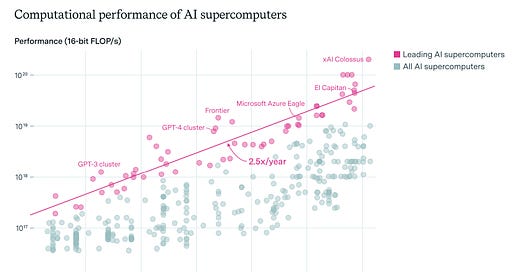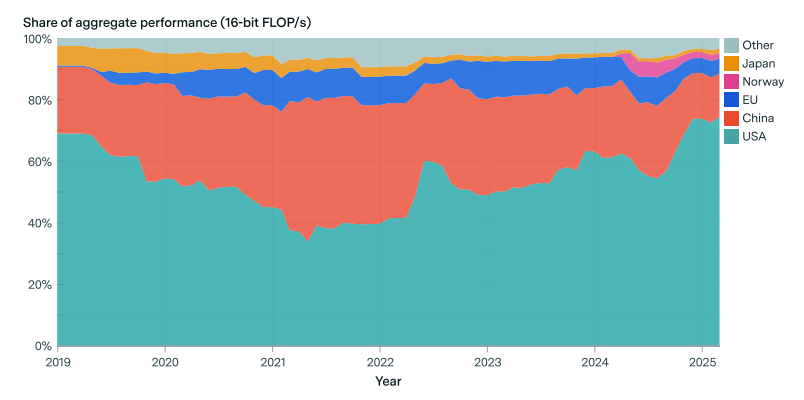The global supercomputer race
Welcome to Cautious Optimism, a newsletter on tech, business, and power.
Happy Thursday! There’s too much to talk about. Enough wasting time, to work! — Alex
📈 Trending Up: Discord’s IPO prospects … smaller fees from the EU … petty responses to smaller EU fees … Russian crimes … A1 in education … hurting ourselves … tariff revenue … Chrome’s worth? … small steps to FSD? …
📉 Trending Down: Supporting free nations … IBM stock after beating market expectations … trucking out of LA … the time until I get my first brain-computer … trade finance companies? … moonlighting in DC …
Headline of the Day: Russia launches huge attack on Kyiv while Trump squeezes Zelenskyy
Read this: TechCrunch’s Mary Ann Azevedo reports that fintech startup funding is finally creeping back up after a long time spent in the doldrums. C’mon, Chime!
Speaking of fintech: Revolut’s 2024 accounts are out. Revenue grew 72%, monthly transactions rose 59%, while profit after tax scaled a bonkers-good 130%.
Grift Alert
It’s easy to look around and declare that nothing matters, but nihilism becomes no one as we, the living, are really here. Thus, we must make the best of things.
That’s why I am incensed, if not surprised that one of the more egregious bits of grift from the Trump family is continuing even past the election. It’s not good for Presidents to have semi-anonymous slush funds that people can put money into at will. It invites corruption.
It’s a bit worse when a President keeps their memecoin grift going while in office, say, by offering large holders of their token dinner with their person. There’s some argument to be made that more naked corruption is just as bad as more obfuscated influence-buying. That argument simply notes that Trump is worse than most, and better than few. I don’t find it exclupatory.
Chart(s) of the Day
From a new paper digging into the scale of sueprcomputers today and how the AI market is pushing compute clusters to new heights, two charts. First, the growth in AI compute cluster power:
And, second, how the growth of AI compute mega-clusters has helped the United States regain primacy in the supercompute market:
A big thanks to Konstantin Pilz, James Sanders, Robi Rahman, and Lennart Heim for their work.
OpenAI, Google and the global AI demand curve
Startups love building AI products. Big companies hungry for cost cuts hope that AI will help them trim fat. Investors have huge wagers on public and private AI companies. But I wonder if consumers aren’t the market-group most excited about AI.
Here’s a short riff from The Information’s Erin Woo:
As of last month, Gemini worldwide was seeing 35 million daily active users and 350 million monthly active users, according to internal Google analysis. Google analysts estimated that ChatGPT was seeing 160 million daily active users and 600 million monthly active users, according to the slide. In October of last year, Gemini was seeing about 9 million DAUs compared with more than 90 million estimated for ChatGPT.
In simple bullet form:
Google’s Gemini grew its daily active user count from 9M in October 2024, to 35M in March 2025.
Per the same Google dataset, OpenAI’s estimated daily active user count grew from 90M to 160M along the same timeframe.
Mix in AI DAUs from Perplexity, Anthropic, other model companies, and even products that are majority-predicated on AI models and the number of global AI DAUs is insane. On a monthly basis it’s way over a billion people. Today. Now, draw the line on the chart out another year.
Revenue is rising, too. From the TWiST500 Ticker newsletter that I wrote yesterday:
Back in late 2024, OpenAI thought it it would grow from around $4 billion in revenue to $12 billion this year. That number, The Information reports, is now closer to $13 billion. OpenAI expects $3 billion more in 2026 revenue, and $10 billion more in 2027. TI reports that AI agents are responsible for some of these boosted expectations at the AI giant, along with new products that have yet to hit the market. OpenAI might be too zealous in its forecasting — but you can’t deny that it’s aiming very, very high.
If OpenAI can reach $13 billion in 2025 revenue, its effective trailing revenue multiple (EoY P/S ratio, if you will), falls to about 23x. That’s pretty cheap, I reckon. Part of OpenAI’s upgraded revenue forecasts include agents, and other new products. Here’s one that might just be a money-printer.
The Tesla earnings call
Pulling from an Investing.com transcript, a few quotes that are worth your time:
Musk, on his work at DOGE:
As so people know, there’s been some blowback for the time that I’ve been spending in government with the Department of Government Efficiency or Doge. I think the work that we’re doing there is actually very important for kind of rein in the insane deficit that is leading our country, United States to destruction. And the Doge team has made a lot of progress in addressing waste and fraud. But natural blowback from that is those who were receiving the wasteful dollars and the fortunate dollars will try to attack me and Doge team and anything associated with me. So but then I’m really left with two choices.
Should we just let the waste and fraud continue? And I was continuing at it to to grow at a really unsustainable pace that was bankrupting the country or to fight the ways and forward and try to get the country back on the right track.
Musk, on protestors of his car company:
Now the the protests that you’ll see out there, they’re very organized. They’re paid for. They’re they’re they’re obviously not going to say admit that the reason that they’re protesting is because they’re receiving fraudulent money or or that they’re the recipients of wasteful largesse, but gonna they’re gonna come up with some other reason. But that is the the the real reason for the protests. The actual reason is that the the is that those receiving the waste and fraud wish to continue receiving it.
Musk, on tariffs:
I’m gonna get a lot of questions about tariffs. And I I I just wanna emphasize that this this the tariff decision is entirely up to the president of The United States. I will weigh in with my advice with the president, which he he will listen to my advice, but then it’s up to him, of course, to make his decision. I I’ve been on the record many times saying that I believe lower tariffs are generally a good idea for prosperity, but this decision is fundamentally up to the elected representative of the people being the president of The United States. So, you know, I’ll continue to advocate for lower tariffs rather than higher tariffs, but that’s all I can do.
Musk, on robotaxis and self-driving timelines:
[Tesla is] currently on track to to be able to do paid rides fully autonomously in Austin in June and and and then to be in any other cities in The US by the end of this year. It’s it’s very difficult. It’s difficult to predict the exact ramp sort of week by week and month by month, except that will ramp up very quickly. So it’s gonna be like some basically an s curve where it’s very difficult to predict the intermediate slope of of the s curve, but you kinda know where the s curve is gonna end up, which is the vast majority of the Tesla fleet being autonomous. So that that’s why I feel confident in predicting large scale autonomy around the middle of next year, but, you know, certainly the second half of next year.
Musk, on ramping production of its Optimus humanoid robot:
Optimus is still very much a development program. It’s not it’s not a, you know, it’s not a large volume production. That’s why, you know, this this year, you know, we’ll make a few that you know, we do expect to make thousands of Optimus robots, but most of that production is gonna be at the end of the year.
So the almost everything in Optimus is new. There’s there’s not, like, an existing supply chain for the motors, gearboxes, electronics, actuators, really anything in the in the almost anything in the Optimus apart from the the AI for Tesla, the Tesla AI computer, which is the same as one in the car. […]
the the rate of the production ramp is decided by how quickly you can solve each of those problems. You know? Optimus was affected, you know, by the magnet issue from China because the Optimus actuators in the arm do use permanent magnets. Now Tesla as a whole does not need to use permanent magnets, but when something is volume constrained, like like an arm of the robot, then you wanna try to make the motors as small as possible. And then so we did the design in permanent permanent magnets for those motors, and those were affected by the supply chain, you know, by by basically China requiring an export license to send out anywhere with magnets.
More tomorrow! <3




